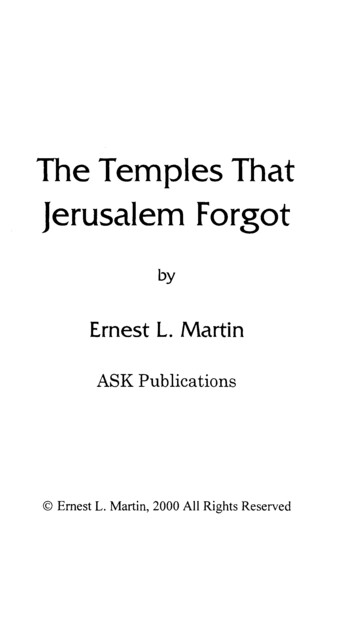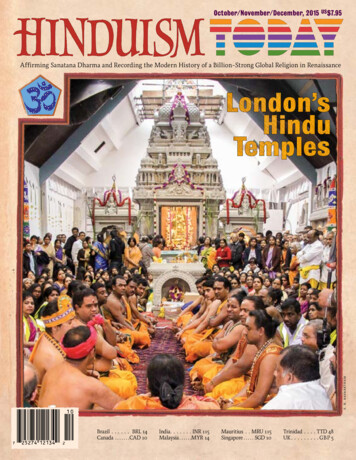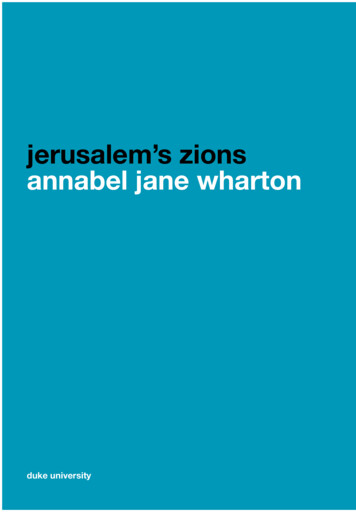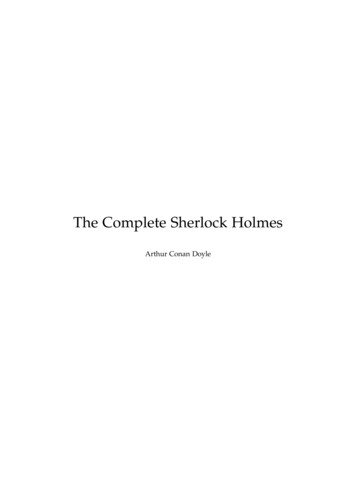
Transcription
The Temples ThatJerusalem ForgotbyErnest L. MartinASK Publications Ernest L. Martin, 2000 All Rights Reserved
DEDICATIONThis book is dedicated to my dear and lovely wife Ramona Jeanwho has gone through the same "blood, sweat and tears" as I havein sharing the time for research and the composition of this book. Ithank her for her patience and kindness. Also, it is dedicated to theAssociates of the "Associates for Scriptural Knowledge" who gaveme the encouragement and support to continue in this task ofhistorical research. I thank them all from the bottom of my heart.From the cowardice that shrinks from new truth,From the laziness that is content with half-truths,From the arrogance that thinks it knows all truth,0 God of Truth, deliver us. Ancient PrayerASK PublicationsP.O. Box 25000, Portland, OR 97298-0990 USAInternet: www.askelm.com Ernest L. Martin, 2000. All Rights Reserved.ISBN 0-945657-95-1
ACKNOWLEDGEMENTSIn this large world in which we live, no man is ever an island. Eachof us is constantly coming in contact with others from whom welearn many valuable teachings that cause us to change our mindson some important occasions. In regard to the discovery of the siteof the Temples in Jerusalem, I have had the pleasure and the goodfortune of being brought into the company of many of the tophistorians and archaeologists of Jerusalem over the period of myprofessional career as a historian and theologian. My first visit toJerusalem in 1961 set my mind on solving the problems thataffected the true geographical comprehension of early Jerusalemthroughout all its periods of history. I watched closely howProfessor Benjamin Mazar and Meir Ben Dov (his assistant at thetime) went about their professional duties and this was a greatlearning experience. Both of them were more than willing toanswer questions for me in the many private times that I couldlearn from them. I later met Professor Mazar's son, Ory, who wasthe first to recommend to me that the Temples of Solomon andZerubbabel were located on the Ophel mound just to the north ofthe original Mount Zion on the southeast ridge. He said his fatherwas leaning in that direction at the time of his death. After a studyof six months, in 1995 I wrote a preliminary report that suggestedstrongly that this theory was indeed correct for the two earlierTemples. I was then under the impression that Simon theHasmonean (along with Herod a century later) moved the Templefrom the Ophel mound to the Dome of the Rock area. Mr. BillLavers in England in reading closely the texts in Josephus
mentioned that Herod stated dogmatically that his Temple (thoughenlarged to be double in size of the former Temple) was stilllocated in the same general area as that of the former Temples.This was also pointed out to me by Dr. James Tabor and DavidSielaff (my historical and compositional editor). But then I noticedthe eyewitness account of Eleazar who led the final contingent ofJewish resistance to the Romans at Masada. He stated that theRoman fortress which had long been in Jerusalem was the onlystructure left by 73 C.E. With this key in mind, I came to theconclusion in 1997 that all the Temples were indeed located on theOphel mound over the area of the Gihon Spring. It then becameclear that the dimensions of the Temple (with its unique shape andcharacteristics) was not the Haram esh-Sharif. We then began todraw (as would an architect) the Temple at its location over theGihon Spring. I had the good fortune of having a professionalartist, who was also interested in biblical matters, draw whatJosephus stated in his writings. My thanks go to Lydia Cooper whoprovided the pictures showing how the Temple and Fort Antonialooked in relationship to one another. The illustrations sheprovided help make the matter much clearer to those who haveonly a limited amount of study into these historical andgeographical matters.This book is a result of my concluding research that shows that theTemples of God in Jerusalem were indeed located over the GihonSpring and not over the Dome of the Rock. What has been amazingto me is the vast amount of Jewish, Muslim and Christian recordsthat remain available from the first to the sixteenth centuries thatclearly vindicate the conclusions that I have reached in this book ofresearch. Any information that you readers may have or discoverthat either support or detract from the conclusions that I have madein this book, would be greatly appreciated by me.Ernest L. Martin"And in that day shall the deaf hear the words of the book, and theeyes of the blind shall see out of obscurity, and out of darkness."Isaiah 29: 18
CONTENTSIntroduction. ······ . 1Part OneThe Wrong Site of the Temples7Chapter 1:What Was the Haram esh-Sharif? . 8Chapter 2:The Roman Fortress at Jerusalem . 33Chapter 3:The Largeness of Fort Antonia . 50Chapter 4:Fort Antonia Was a Roman City . 60Chapter 5:The Harem esh-Sharif Was Fort Antonia . 75Chapter 6:The Rock and the Fortress of Antonia . 82Chapter 7:The Significance of the "Rock" under the Domeof the Rock . 93Part TwoThe Original Site of the Temples at JerusalemChapter 8:107Many Modern Sites for the Temples in �··········· 108Chapter 9:The Real Jewish Site of the Temples . 142Chapter 10:All Jewish Buildings in Jerusalem Destroyed in70 C.E . 163Chapter 11:Every Stone Uprooted from the Temple . 168Chapter 12:Ruins of the Temple in Southeastern Jerusalem . 199Chapter 13:The First "Western (Wailing) Wall" . 218Chapter 14:The Actual Temple Site from 638 to 1099 C.E . 233
Part Three247The Biblical History of the Temples unto Herod the GreatChapter 15:The Garden of Eden, the Tower of Babel and theTemple of God . 248Chapter 16:Where Did Solomon Build the Temple? . 262Chapter 17:The Centrality of the Early Temples . 271Chapter 18:The Temple on the Southeast Ridge . 2 77Chapter 19:The Prime Position of the Temple . 283Chapter 20:The Original Temple Over the Gihon Spring . 288Chapter 21:Necessary Spring Waters within the Temples . 308Chapter 22:Where Was the Akra? . 322Chapter 23:The City of David and the Op he I . 331Chapter 24:Critical Problems Facing Simon the Hasmonean . 340Chapter 25:A New Temple Had to be Built . 356Chapter 26:The Dead Sea Scrolls and the New Jerusalemof Simon . 363Chapter 27:Resistance to Simon's Rule . 368Chapter 28:Simon's Building Projects . 381Chapter 29:The Temple in the Book of Enoch . 3 87Chapter 30:Rebuilding the Temple . 396Part FourThe Position and Description of Herod's Temple409Chapter 31:Descriptions of Fort Antonia and the Templeof Herod . 410Chapter 32:The Colonnades from the Temple to Fort Antonia . 423Chapter 33:The Temple that Josephus Knew . 432Chapter 34:The Proper Comparisons of the Temple . 456Chapter 35:How Could the Rabbis Forget? . 471
INTRODUCTIONIT IS WELL KNOWN that Herod (called "the Great")vastly modified the geography of the Temple and the City ofJerusalem. Herod made the Mother City of the Jewish peopleinto one of the most urbanized areas in the Roman Empire. So outstanding did Jerusalem become that it was favorably compared inarchitectural majesty, grandeur and prosperity with Rome andother great cities of the Empire. What Herod also did was to rebuild and to increase the size of the Temple. Next to the Sanctuaryhe reconditioned a fortress formerly called the Baris and renamedit Fort Antonia after Mark Anthony. To the west of the Temple,Herod constructed his palace and three major citadels in what wascalled the Upper City.In spite of these accomplishments that scholars recognize today,people are still not aware what the Jerusalem of Herod and Jesuswas really like. This book will show that Herod also created a Jerusalem with a topography quite different from that imagined bymost modern historians and by our present religious authorities.Once this actual Jerusalem is recognized (and the proper locationof the Temple determined), this new understanding will have aprofound influence on how modern Jews and Muslims (as well asChristians) view the contemporary and future political status ofJerusalem. The antagonists fighting one another in the Holy Citywill come to realize that they are struggling over areas that havenothing to do with the former site of the Temple of Herod (nor theTemples of Solomon or Zerubbabel which were built in the samelocation). Strange as it may seem, the religious authorities of allthe three Abrahamic creeds have forgotten where those Temples1
2Tlte Temples tltat Jerusalem Forgotwere built. Only in the last two years have their sites been discovered for our modern world to recognize.This loss of the Temple site by our contemporary religiousleaders and scholars has happened even though the Holy Scripturesencouraged the faithful never to forget Jerusalem. What thePsalmist stated has long been echoed by Israelites in their prayersover the centuries."If I forget thee, 0 Jerusalem, let my right hand forget her cunning.If I do not remember thee, let my tongue cleave to the roof of mymouth, ifl prefer not Jerusalem above my chief joy." Psalm I 3 7: 5-6This is a beautiful sentiment expressed by the Psalmist, but asfar as the historical records are concerned for the past 800 yearsnot only have Israelites forgotten the true geography of early Jerusalem, the whole world has also forgotten (and this includes theMuslim and Christian authorities). The actual site of the Templelanguishes in Jerusalem forlorn, lonely, abandoned and thoroughlyforgotten.Yet the present religious authorities exalt to the highest esteemand respect an enclosure as the site of the Temple that was inJesus' day the chief architectural symbol of Rome's claim to imperial world power. As a result, all religious leaders in Jerusalem andthe world remain ignorant of the true location of the Temples ofGod. Even the worshippers at the "Wailing Wall" are directingtheir present devotions and venerations to a Roman edifice thattheir ancestors in Herod's time held in utter contempt.This book, however, will identify in the clearest of ways wherethe Temples of Solomon, Zerubbabel and Herod were actuallylocated. In fact, it is a simple process to discover the site of theformer Temples. If a person can pinpoint the original "MountZion," then he or she will also find the "Temple Mount" becausethe two terms are acknowledged as identical in several biblicalcontexts. Indeed, the first place the scholars and religious leadersmisplaced (and finally forgot) was the location of the original"Mount Zion" that King David built and named. The real "MountZion" was situated at the lower end of the southeast ridge (and this
The Temples that Jerusalem Forgot3was rediscovered from the years 1875 to 1885 C.E. 1 by the vigorous and almost single handed efforts of Professor Birch in England. But the scholars forgot that in correctly re-locating "MountZion" on the southeast ridge of Jerusalem, they should have movedthe site of the Temples to the same southeast ridge (but slightlynorth of "Mount Zion"). This necessary task was not onlyneglected by the scholars, they dug in their trenches and began todefend the Haram esh-Sharif with its Dome of the Rock as theproper place for the former Temples. They were absolutely wrongin this assessment.But look at the simple facts. Since everyone now knows that the"Mount Zion" of King David's time was located in the southernpart of Jerusalem on its southeast ridge, this means that the Temples would have to be located immediately north on what wascalled the "Ophel'' in the Scriptures (but NOT a third of a milenorth to the Dome of the Rock). This well known geographical factsignifies that the real site of the Temples was a few yards (meters)west of the Gihon Spring, about a third of a mile south of theDome of the Rock now situated within the enclosure of the Haramesh-Sharif.Thankfully, modern scholars and religious leaders over a hundred years ago properly returned "Mount Zion" to its originallocation on the southeast ridge, but they failed to return with it the"Temple Mount" as common biblical sense would have demanded.The historians and religious officials (with their opinions chiseledin stone so it seems) tenaciously maintain that the site of the formerTemples is in the region of the Haram esh-Sharif. Their resistanceto the true biblical site (mainly because of their religious convictions) has caused the whole world to reject the proper location ofthe Temples.It is sad to witness, but the real "Temple Mount" is presently ina forsaken state and the site is deserted of all its holiness that once1 In this book I will use the scholarly C.E. (Common Era) and B.C.E. (BeforeCommon Era) instead of the usual A.O. and B.C. for identifying particular yearsin history. Since I have shown i
Ernest L. Martin "And in that day shall the deaf hear the words of the book, and the eyes of the blind shall see out of obscurity, and out of darkness." Isaiah 29: 18 . CONTENTS Introduction . ······ . 1 Part One 7 The Wrong Site of the Temples Chapter 1: What Was the Haram esh-Sharif? . 8 Chapter 2: The Roman Fortress at Jerusalem . 33 Chapter 3: The Largeness of Fort .











